This female American Kestrel has been hanging around the same area of Farmington for almost two weeks now. Yesterday morning we found her near the end of one of her meals.
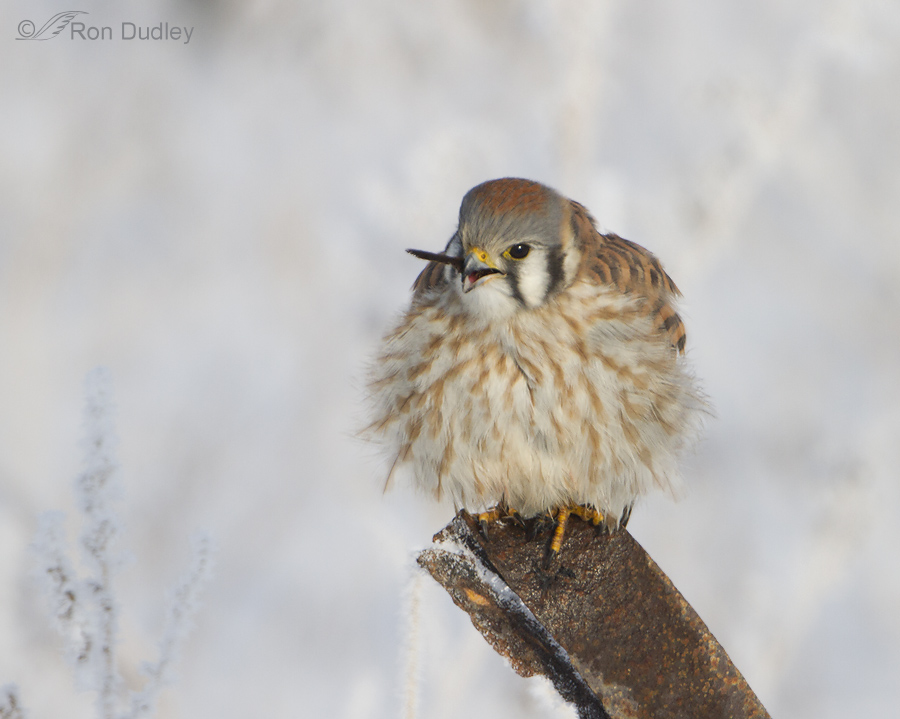 1/2000, f/5.6, ISO 500, 500 f/4, 1.4 tc, not baited, set up or called in
1/2000, f/5.6, ISO 500, 500 f/4, 1.4 tc, not baited, set up or called in
She was just finishing up with a small bird, possibly a junco. There wasn’t much left of the bird except part of the wing or tail which she had a difficult time swallowing – flight feathers and all.
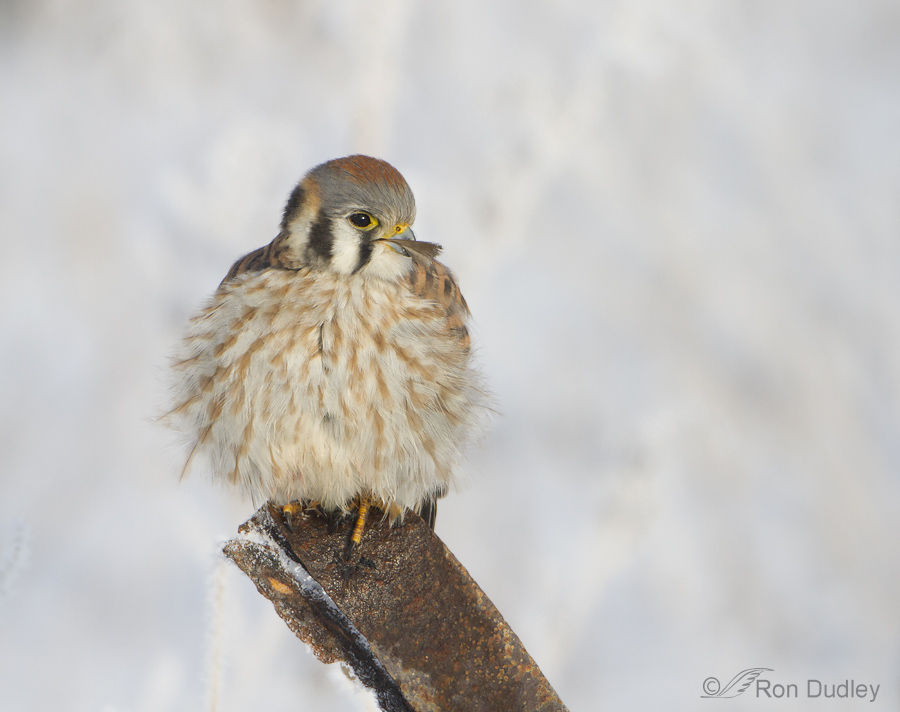 1/2000, f/5.6, ISO 500, 500 f/4, 1.4 tc, not baited, set up or called in
1/2000, f/5.6, ISO 500, 500 f/4, 1.4 tc, not baited, set up or called in
Here she paused in her efforts for a few moments and I thought she might have to expel this part of the meal but eventually she got it down. The morsel was almost entirely feathers with just a small piece of flesh on one end. I guess every little bit of sustenance is critical in harsh conditions like this (cold and snow).
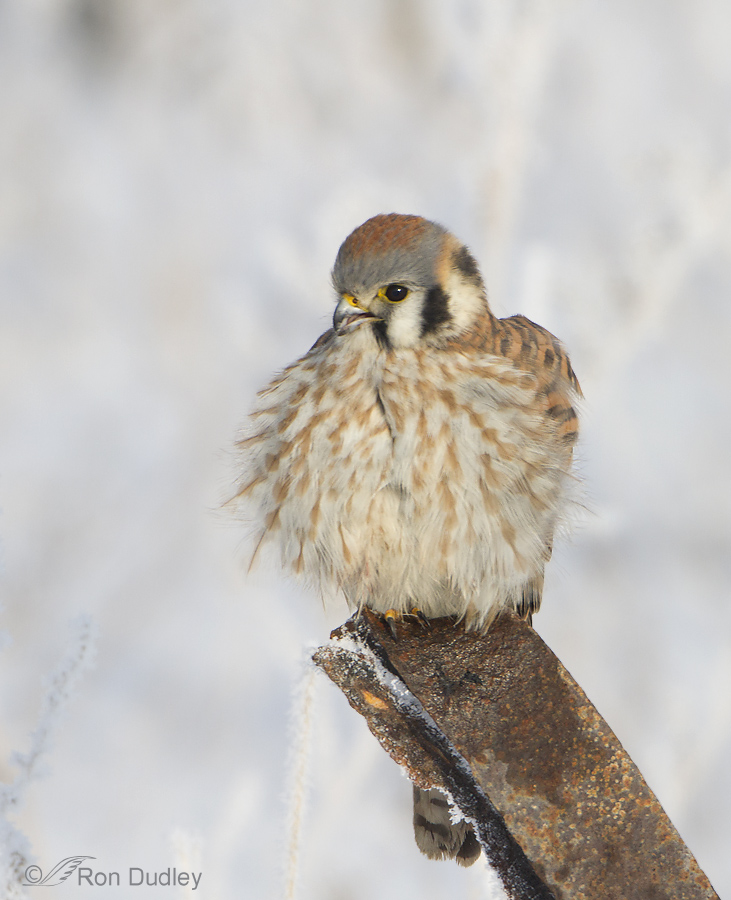 1/1600, f/6.3, ISO 500, 500 f/4, 1.4 tc, not baited, set up or called in
1/1600, f/6.3, ISO 500, 500 f/4, 1.4 tc, not baited, set up or called in
After the meal she did a little grooming (cleaning her feet in particular) and then sat here calmly for a period, despite the earsplitting noise coming from a hunter’s airboat warming up very close by. This is the second time I’ve watched her calmly eat her meal from this spot while nearby airboats were producing an incredible racket. She’s a gutsy little falcon.
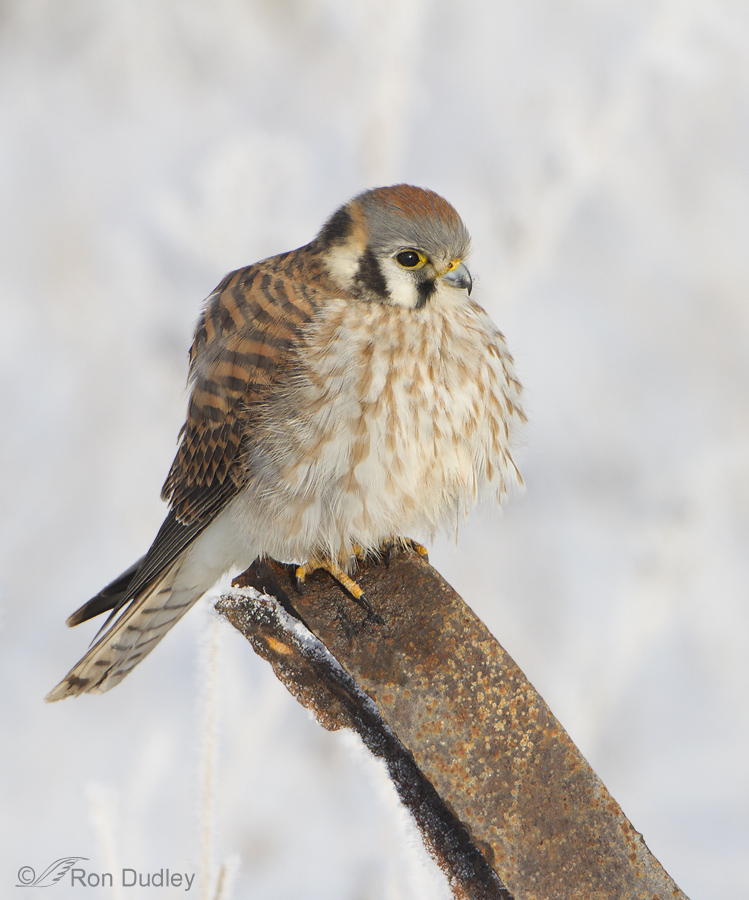 1/1600, f/6.3, ISO 500, 500 f/4, 1.4 tc, not baited, set up or called in
1/1600, f/6.3, ISO 500, 500 f/4, 1.4 tc, not baited, set up or called in
In her previous pose I could see very little of the tail so I was happy when she turned slightly just prior to take-off. I was struck by the similarities in colors and even patterns of her plumage and the rusty angle iron perch – thus my title.
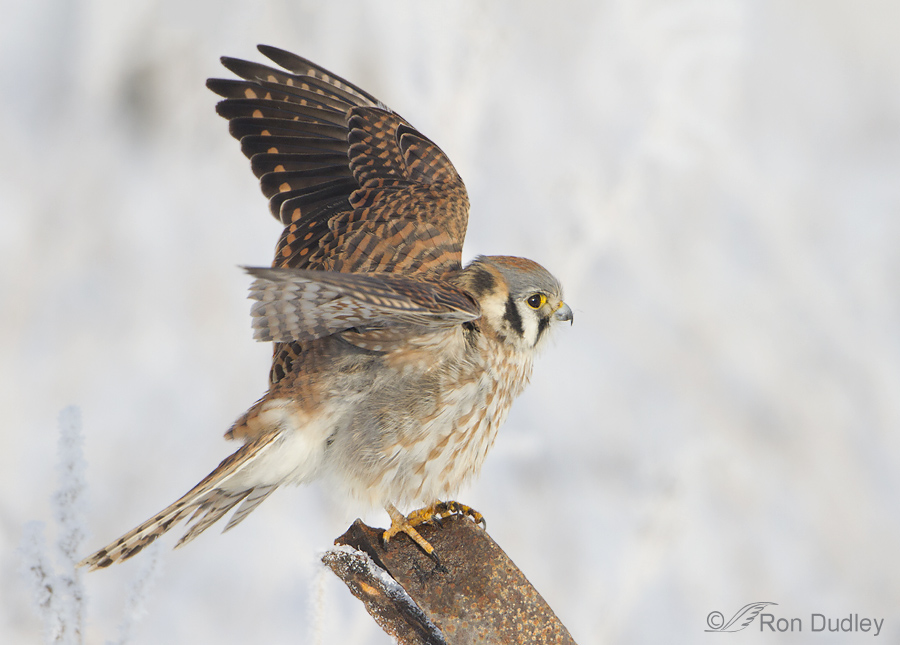 1/1600, f/6.3, ISO 500, 500 f/4, 1.4 tc, not baited, set up or called in, sliver of canvas added for composition
1/1600, f/6.3, ISO 500, 500 f/4, 1.4 tc, not baited, set up or called in, sliver of canvas added for composition
When larger falcons (Peregrine and Prairie, for example) take off they often hold their wings up high for a moment before they lift off but in my experience (even though they too are falcons) this is something kestrels seldom do Usually kestrel take-off is instantaneous but this little lady fooled me and acted like one of her larger cousins just prior to lift-off.
I plan on going out shooting later this morning and you can bet that I’ll be looking for this tough little falcon once again.
Ron


My English friends have told me how “friendly” their English robins are, how they follow them around when they are gardening, especially if they are digging and turning over the soil….that this is NOT happening in Ingrid’s garden, is unusual to say the least…
What a gorgeous little bird – a fluff ball that looks as if butter wouldn’t melt in her mouth! And I absolute love to see her on the rusty perch. Another marvelous insight in you beautiful bird life. You may be interested that, even though we are in the 2nd half of December, we have literally not seen ONE bird in our garden, in spite of a variety of six different foods, and we live in a little village about 100 meters from the sea. I phoned the RSPB yesterday, and apparently they are inundated from people who are also worried. They think it is just that it has been unusually mild so far, and the berries have been particularly good this year. But we have loads of berries in our garden, too, and have not cut any of our annuals down, keeping both the birds and the bugs in mind. I have never known anything like this in the UK (and I’m 60)!
Kind regards to you and yours, Ron, from Ingrid
That’s a very scary situation you describe, Ingrid. For the last 5 months birds have been slower around here than I’ve ever seen them. I fear climate change may be responsible…
Ingrid in the UK, you in Utah, me on the east US….similar patterns…VERY scary!!!
ConsiderablyIngrid, your comments really worry me. We live in the mid-Atlantic area of the US and are seeing considerably less than half the number of birds we’re used to seeing. We were away for two months this summer into early fall and noticed this when we came back. We have a number of feeders with a variety of seed and suet. Right now we have some sparrows,Juncos, chickadees, titmice and Jays and a few other birds, but none in the numbers we’re used to seeing. We thought it was because we broke up their feeding pattern…or maybe the presence if a hawk, but we haven’t seen a hawk either. That you’re seeing something similar is a bit scary.
Hi Patty. Yes, that’s how I feel. Nice to hear you at least still have a variety of birds. I am not exaggerating when I say that we have not even seen any bird, apart from the odd seagull, fly overhead. Also, my husband just spent about 2 weeks digging and re-digging an enormous patch of ground, which is seething in ground worms. It almost makes me cry to say that not even one little Robin ever appeared. We are used to, only coming into the garden with a spade, makes a Robin appear and keeping you company all the time through the digging period.
Ron may well be right (but I do hope not!!!) …. might it be climate change? Although I do have to say that when I walk through the woods with my dogs, we still see a few Robins and Blue Tits 🙂
Ingrid–when I mentioned these different birds, I meant one or two, no more of each, at best. We are NOT seeing ANY of them in the numbers we are used to seeing. We used to see several at a time, or in small flocks. Those that weren’t on the feeders would be waiting in nearby branches. Now we see one chickadee, one nuthatch, one jay, one titmouse at a time. We are seeing a small flock of Juncos, but NONE of the other birds in the same numbers we saw them last year and years before…It is very different…VERY QUIET…and very concerning. Hearing about your experience and Ron’s makes the picture worse. I’m going to contact relatives in other parts of this country and see what’s going in in their areas.
Thanks, Maya…YOU were the one that answered my question so clearly, I automatically thanked Ron…he so patiently answers my ignorant questions, I just automatically thought he had responded. I really enjoy your comments. Thanks,nagsin.
Ron–you say you saw that little beauty eating a frozen vole…that must have been like trying to eat a rock with the crazy low temps you’ve been having! She may be a tough, feisty bit of a bird, but that’s one rugged life she’s leading.! My heart goes out to her! I hope she makes it through the winter. We’ve lost so many of them, it breaks my heart….
Patty, It was half of a vole (the rear half) and it was frozen rock solid but she had no trouble pulling off pieces of meat.
She’s a beautiful and tough bird. Some interesting comments too.
I agree, Sonja – on both counts.
Great detail in her wings in the last shot and aptly named title!
What a maximally fluffed bird! She is certainly squeezing every last bit of insulation out of her feathers. I have some understanding of the precarious survival birds must wrest from the wild, but living with my non-releasable captive raptors occasionally tweaks my perspective. It’s going down to single digits (above) here tonight, and I just gave my peregrine falcon, Valkyrie, a nice big Coturnix quail (defrosted from my freezer) for her late day meal. A quail from which I’d removed most of the feathers to save her plucking them (because she doesn’t pick up after herself). She’d pluck them without complaint, but I cannot imagine her eating flight feathers! Not in her current coddled circumstances, that is. It plucked at my heart to see that brave little kestrel swallowing indigestible material just to get the fragment of meat still attached.
Now my peregrine is roosting in the cold… perched in a covered roost box next to a radiant heat panel. Since peregrines have bare legs and don’t stay here in New England winters (she’d have migrated anywhere south that her heart and appetite led her), I’ve been feeling sorry for her in this arctic air. After seeing your little kestrel facing winter alone, I’m not feeling quite as sorry for Val as I had! Not that she wouldn’t trade her current comfort for a wild and free life if she could… but electrocution on high power lines during her first year migration ( presumably from the Yukon bound for South America) robbed her of that chance.
Your female kestrel reminded me of an interesting and perhaps little known factoid about these very small falcons. (With your wide knowledge, Ron, I don’t expect it’s news to you). Since they are so small but population biology dictates that whenever possible they have relatively large clutches of eggs (even 10!), both female AND male kestrels develop brood patches so they can incubate their eggs together side by side. Unusual arrangement. So your gutsy female kestrel needs not only to find enough food to survive the biting cold, she needs quite soon to be storing calcium and other nutrients to make ready for her eggs. I wish her good hunting.
As always, thanks for inspiring and provocative images.
A fascinating and heart-felt comment, Maya. I’ve read it twice and likely will again. I thank you for it.
Maya: You must be speaking of the Common Kestrel, Falco tinnunculus, (1 0f 13 recognized Kestrel species of the world). Our American Kestrel, Falco sparverius, will only lay up to 7 eggs in a clutch but generally averages 4-5. Many raptor species share incubation chores and both genders will have a brood patch.
Bill
What a wonderful series of a beautiful bird Ron!
Thank you, Charlotte.
Thank you for the wonderful photos and interesting narrative. Cold weather is tough on all of us, but I wonder how the birds handle the smog…..
I’ve wondered the same thing, Tana but many of the raptors seem to prefer being along the Wasatch Front during winter so maybe they handle it ok. There sure seems to be more of them in the populated (and more smoggy)) areas of the valley than there are further out. Believe me, I know – from my many trips thither and yon looking for them…
Great photographs, great composition, great bird!
Sometimes even an unnatural perch is, well — natural!
Thanks, Wally. I agree about the perch and like it too.
Love it! Thanks and happy holidays to you and all those feisty little falcons 🙂
Thank you, Nala. And the same to you.
I usually look at your images several times…visit and revisiting your blog.. To me, the rusty iron in these images is every bit as beautiful as a lichen covered rock or a snowy branch…of course iron is a natural substance, however it is wangled into an artificial shape…and rust , oxidation, is the equalizer. My father used to scupt things in cor tense steel just for the rusty patina.
Patty, I like that rusty perch too, despite the fact that it isn’t natural (in the form it’s in).
Such an enchanting little bird. I hope she continues to do well. Very well.
I saw her (I’m pretty sure it was her) this morning, Elephant’s Child. She was eating a frozen vole. I suspect it had been cached.
I love these beautiful images…especially the spikey look off the fluffed up feathers and the feather detail in the lifted wing…I do wish they didn’t eat other birds, like Juncos (we call them “snow birds”)…I would rather they ate weather loaches…And voles. Well, maybe not. I’ve been researching loaches and apparently they are “friendly” fish that actually seem to like being handled! Maybe we could encourage them to eat politicians,copyright infringers, telemarketers, and plagiarists…then we’d ALL be better off!!! Just one of those for a meal should last a bird as small as a kestrel for a long time…..
Birds eat birds (some raptors eat other raptors); mammals eat mammals; insects insects; birds eat reptiles, fish, mammals, insects (and vise-versa for these groups). And on some occasions their own progeny. It is nature and I’m not sure its for us to judge. They do what works.
Bill
DUH!!!
Eating copyright infringers,telemarketers, plagiarists, politicians, etc. works for me….beats eating an innocent (or not so innocent) cow, pig, chicken, turkey, etc. anyway…unless you prefer loaches and voles….
Oh, no, Patty! Are you turning into a cannibal?????? 🙂
No cannibalism involved. Those types mentioned by Patty are surely not human. Some sort of fungus is my best guess.
You are so right!!!!
I love the way you think, Elephant’s Child! Of course you are right…
Absolutely!!!
Patty, around here they mostly eat voles. I’ve only seen them eating birds a few times. Voles – hundreds of times.
These shots are some of your best!!! And all of your shots are always great! The details are beautiful. I know it is a little freaky that some birds eat other birds. Seeing the tail feathers sticking out of her mouth just made me laugh. Maybe I’m nuts. I’ve never seen this species live and in person. Would love to. This whole series is terrific!!! Wings spread for take off!
I’m delighted that you like them, Ellen. And no, you’re not nuts – or I am too because I always get a kick out of seeing a voles tail (or occasionally flight feathers) sticking out as the bird attempts to swallow them. It’s very difficult for them though. Several times I’ve seen them expel them and start over, but in the end they’ve never failed that I’ve seen.
Beautiful series on a wonderful bird. At first glance, the first photo looked as if she had a toothpick in her mouth… I love how gutsy American Kestrels are – that’s a major reason why they’ve become my favorite bird. We haven’t seen our local Kestrels in a while, so I appreciate the ‘fix’.
“Gutsy” is the perfect word for them, Susan. There’s a series of photos circulating on FB of a kestrel stealing a vole from a Barn Owl while both are in flight. (kestrels are maybe 1/4 the size of a barn owl)
I learn so much through your pictures. Knowing birds eat birds is one thing. Seeing them with feathers emerging from their beak gives me a much more – visceral – sense of it! Thanks for these intimate views of bird life, Ron.
Alison, a couple of days ago I photographed this bird with a voles tail poking out of its beak for a little variety…
She’s wonderful. I love the rusty colors against the snow. Beautiful photos.
Thanks, Sharon.
Ron, your quick shot of her raised wings after rousing is wonderful. And you are correct, the color of her perch makes her feathers and the rust on her head jump out.
Thanks so much
I’m glad you like the color combinations, Diana.
What is “rousing”?
Patty, rousing (the feathers) refers to a common bird behavior for putting feathers back in place after their getting disarranged (by preening or by some other activity). The bird uses the muscles that attach at the base of each feather to raise all the feathers up, much like the kestrel is doing to trap body heat to stay warm. But instead of keeping them raised, the bird quickly shakes all over (something like a wet dog) then lets all the feathers fall back into their proper places. The result of rousing is a perfectly coiffed bird again.
Love your comments! Always a lot of thought behind them.
Thanks, Ron–I’ve seen my rescues do this many times , but didn’t realize the action had a name. I just called it “shuffling their feathers). I’ve seen “my” birds do it after sun bathing. They’d lift every feather on end so that the sunlight could reach the skin…something they obviously needed. Sometimes turtle vitamin drops in their water has helped. I’ve also seen wild chickadees do it while lying on the top rail of a stockade fence. Again, the “rousing” occurs when the sunbathing is over. My experiences with birds and other wild things have been somewhat in “isolation”, so I have my own terms for things. One of the things I love about your blog is finally learning the correct terminology. I love learning things from you, Mia and your followers. Obviously, I’m full of dumb questions…but, so be it(I’m a lot smarter now than I was before I discovered your blog!)…